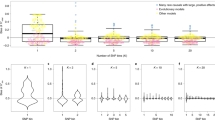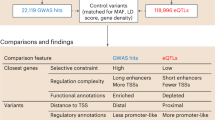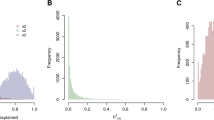Key Points
-
Expression levels of genes are heritable traits. Genetic determinants of individual variation in human gene expression can be mapped by linkage and association analyses.
-
Cis- and trans-acting DNA variants influence expression levels of genes. Genetics of gene expression (GOGE) studies have identified cis-acting regulatory variants of many genes; however, few trans-acting variants have yet been identified.
-
In humans, ∼30–50% of cis-acting variants identified in immortalized B cells have the same effects in other cell types, such as adipose tissue and blood.
-
Differences in genotype frequencies of regulatory alleles contribute to population differences in gene expression.
-
By combining results from GOGE studies with correlation analysis, one can construct directed gene co-expression networks that provide information on causal rather than just correlative relationships. The results also extend regulatory relationships from pairs to groups of genes.
-
GOGE studies in cells exposed to cellular, medical or environmental perturbations will uncover additional regulators of human gene expression.
Abstract
There is extensive natural variation in human gene expression. As quantitative phenotypes, expression levels of genes are heritable. Genetic linkage and association mapping have identified cis- and trans-acting DNA variants that influence expression levels of human genes. New insights into human gene regulation are emerging from genetic analyses of gene expression in cells at rest and following exposure to stimuli. The integration of these genetic mapping results with data from co-expression networks is leading to a better understanding of how expression levels of individual genes are regulated and how genes interact with each other. These findings are important for basic understanding of gene regulation and of diseases that result from disruption of normal gene regulation.
This is a preview of subscription content, access via your institution
Access options
Subscribe to this journal
Receive 12 print issues and online access
$189.00 per year
only $15.75 per issue
Buy this article
- Purchase on Springer Link
- Instant access to full article PDF
Prices may be subject to local taxes which are calculated during checkout




Similar content being viewed by others
References
Brem, R. B., Yvert, G., Clinton, R. & Kruglyak, L. Genetic dissection of transcriptional regulation in budding yeast. Science 296, 752–755 (2002).
Cheung, V. G. & Spielman, R. S. The genetics of variation in gene expression. Nature Genet. 32, 522–525 (2002).
Cheung, V. G. et al. Natural variation in human gene expression assessed in lymphoblastoid cells. Nature Genet. 33, 422–425 (2003).
Schadt, E. E. et al. Genetics of gene expression surveyed in maize, mouse and man. Nature 422, 297–302 (2003).
Jansen, R. C. & Nap, J. P. Genetical genomics: the added value from segregation. Trends Genet. 17, 388–391 (2001).
Morley, M. et al. Genetic analysis of genome-wide variation in human gene expression. Nature 430, 743–747 (2004).
Cheung, V. G. et al. Mapping determinants of human gene expression by regional and genome-wide association. Nature 437, 1365–1369 (2005).
Stranger, B. E. et al. Genome-wide associations of gene expression variation in humans. PLoS Genet. 1, e78 (2005).
Stranger, B. E. et al. Relative impact of nucleotide and copy number variation on gene expression phenotypes. Science 315, 848–853 (2007).
DeRisi, J. et al. Use of a cDNA microarray to analyse gene expression patterns in human cancer. Nature Genet. 14, 457–460 (1996).
Fodor, S. P. et al. Multiplexed biochemical assays with biological chips. Nature 364, 555–556 (1993).
Farrall, M. Quantitative genetic variation: a post-modern view. Hum. Mol. Genet. 13, R1–R7 (2004).
Rockman, M. V. & Kruglyak, L. Genetics of global gene expression. Nature Rev. Genet. 7, 862–872 (2006).
Li, J. & Burmeister, M. Genetical genomics: combining genetics with gene expression analysis. Hum. Mol. Genet. 14, R163–R169 (2005).
Nica, A. C. & Dermitzakis, E. T. Using gene expression to investigate the genetic basis of complex disorders. Hum. Mol. Genet. 17, R129–R134 (2008).
Stranger, B. E. & Dermitzakis, E. T. The genetics of regulatory variation in the human genome. Hum. Genomics 2, 126–131 (2005).
Gilad, Y., Rifkin, S. A. & Pritchard, J. K. Revealing the architecture of gene regulation: the promise of eQTL studies. Trends Genet. 24, 408–415 (2008).
International HapMap Consortium. The International HapMap Project. Nature 426, 789–796 (2003).
International HapMap Consortium. A haplotype map of the human genome. Nature 437, 1299–1320 (2005).
Redon, R. et al. Global variation in copy number in the human genome. Nature 444, 444–454 (2006).
Moffatt, M. F. et al. Genetic variants regulating ORMDL3 expression contribute to the risk of childhood asthma. Nature 448, 470–473 (2007). Demonstrates that regulatory variants of expression of ORMDL3 influence an individual's susceptibility to asthma.
Dixon, A. L. et al. A genome-wide association study of global gene expression. Nature Genet. 39, 1202–1207 (2007).
Cookson, W., Liang, L., Abecasis, G., Moffatt, M. & Lathrop, M. Mapping complex disease traits with global gene expression. Nature Rev. Genet. 10, 184–194 (2009).
Cheung, V. G. et al. Genetics of quantitative variation in human gene expression. Cold Spring Harbor Symp. Quant. Biol. 68, 403–407 (2003).
Monks, S. A. et al. Genetic inheritance of gene expression in human cell lines. Am. J. Hum. Genet. 75, 1094–1105 (2004).
Emilsson, V. et al. Genetics of gene expression and its effect on disease. Nature 452, 423–428 (2008).
Goring, H. H. et al. Discovery of expression QTLs using large-scale transcriptional profiling in human lymphocytes. Nature Genet. 39, 1208–1216 (2007).
Choy, E. et al. Genetic analysis of human traits in vitro: drug response and gene expression in lymphoblastoid cell lines. PLoS Genet. 4, e1000287 (2008).
Zhang, W. et al. Evaluation of genetic variation contributing to differences in gene expression between populations. Am. J. Hum. Genet. 82, 631–640 (2008).
Storey, J. D. et al. Gene-expression variation within and among human populations. Am. J. Hum. Genet. 80, 502–509 (2007).
Duan, S. et al. Genetic architecture of transcript-level variation in humans. Am. J. Hum. Genet. 82, 1101–1113 (2008).
Myers, A. J. et al. A survey of genetic human cortical gene expression. Nature Genet. 39, 1494–1499 (2007).
Schadt, E. E. et al. Mapping the genetic architecture of gene expression in human liver. PLoS Biol. 6, e107 (2008).
Whitney, A. R. et al. Individuality and variation in gene expression patterns in human blood. Proc. Natl Acad. Sci. USA 100, 1896–1901 (2003).
Krattinger, S. G. et al. A putative ABC transporter confers durable resistance to multiple fungal pathogens in wheat. Science 323, 1360–1363 (2009).
Grisart, B. et al. Genetic and functional confirmation of the causality of the DGAT1 K232A quantitative trait nucleotide in affecting milk yield and composition. Proc. Natl Acad. Sci. USA 101, 2398–2403 (2004).
Ioannidis, J. P., Thomas, G. & Daly, M. J. Validating, augmenting and refining genome-wide association signals. Nature Rev. Genet. 10, 318–329 (2009).
Cheung, V. G. et al. Monozygotic twins reveal germline contribution to allelic expression differences. Am. J. Hum. Genet. 82, 1357–1360 (2008).
Pant, P. V. et al. Analysis of allelic differential expression in human white blood cells. Genome Res. 16, 331–339 (2006). A thorough study of differential allelic expression of human genes on a genome-wide scale.
Pastinen, T. et al. A survey of genetic and epigenetic variation affecting human gene expression. Physiol. Genomics 16, 184–193 (2004).
Pastinen, T., Ge, B. & Hudson, T. J. Influence of human genome polymorphism on gene expression. Hum. Mol. Genet. 15, R9–R16 (2006).
Lo, H. S. et al. Allelic variation in gene expression is common in the human genome. Genome Res. 13, 1855–1862 (2003).
Price, A. L. et al. Effects of cis and trans genetic ancestry on gene expression in African Americans. PLoS Genet. 4, e1000294 (2008).
Mortazavi, A., Williams, B. A., McCue, K., Schaeffer, L. & Wold, B. Mapping and quantifying mammalian transcriptomes by RNA-Seq. Nature Methods 5, 621–628 (2008).
Knight, J. C., Keating, B. J., Rockett, K. A. & Kwiatkowski, D. P. In vivo characterization of regulatory polymorphisms by allele-specific quantification of RNA polymerase loading. Nature Genet. 33, 469–475 (2003). Description of a molecular method that assesses whether cis -regulatory variants influence gene expression by differential allelic binding of RNA polymerase to promoter complexes.
Liu, X. et al. Expression-based discovery of variation in the human glutathione S-transferase M3 promoter and functional analysis in a glioma cell line using allele-specific chromatin immunoprecipitation. Cancer Res. 65, 99–104 (2005).
Fritsche, L. G. et al. Age-related macular degeneration is associated with an unstable ARMS2 (LOC387715) mRNA. Nature Genet. 40, 892–896 (2008).
Mio, F. et al. A functional polymorphism in COL11A1, which encodes the α1 chain of type XI collagen, is associated with susceptibility to lumbar disc herniation. Am. J. Hum. Genet. 81, 1271–1277 (2007).
Sankaran, V. G. et al. Human fetal hemoglobin expression is regulated by the developmental stage-specific repressor BCL11A. Science 322, 1839–42 (2008). Illustrates that BCL11A is a trans -acting regulator of fetal haemoglobin expression.
Yvert, G. et al. Trans-acting regulatory variation in Saccharomyces cerevisiae and the role of transcription factors. Nature Genet. 3, 57–64 (2003).
Spielman, R. S. et al. Common genetic variants account for differences in gene expression among ethnic groups. Nature Genet. 39, 226–230 (2007).
The International Hapmap Consortium. A haplotype map of the human genome. Nature 437, 1299–1320 (2005).
Hartford, C. M. et al. Population-specific genetic variants important in susceptibility to cytarabine arabinoside cytotoxicity. Blood 113, 2145–2153 (2009).
Chesler, E. J. et al. Complex trait analysis of gene expression uncovers polygenic and pleiotropic networks that modulate nervous system function. Nature Genet. 37, 233–242 (2005).
DeCook, R., Lall, S., Nettleton, D. & Howell, S. H. Genetic regulation of gene expression during shoot development in Arabidopsis. Genetics 172, 1155–1164 (2006).
Hubner, N. et al. Integrated transcriptional profiling and linkage analysis for identification of genes underlying disease. Nature Genet. 37, 243–253 (2005).
Breitling, R. et al. Genetical genomics: spotlight on QTL hotspots. PLoS Genet. 4, e1000232 (2008).
Benfey, P. N. & Mitchell-Olds, T. From genotype to phenotype: systems biology meets natural variation. Science 320, 495–497 (2008). A thought-provoking review of how natural variation in gene expression can be used for network and other systems analysis. Although the focus is on plants, the ideas can be translated to all organisms.
Jordan, I. K., Marino-Ramirez, L., Wolf, Y. I. & Koonin, E. V. Conservation and coevolution in the scale-free human gene coexpression network. Mol. Biol. Evol. 21, 2058–2070 (2004).
Lee, H. K., Hsu, A. K., Sajdak, J., Qin, J. & Pavlidis, P. Coexpression analysis of human genes across many microarray data sets. Genome Res. 14, 1085–1094 (2004).
Gargalovic, P. S. et al. Identification of inflammatory gene modules based on variations of human endothelial cell responses to oxidized lipids. Proc. Natl Acad. Sci. USA 103, 12741–12746 (2006).
Harbison, S. T. et al. Co-regulated transcriptional networks contribute to natural genetic variation in Drosophila sleep. Nature Genet. 41, 371–375 (2009).
Ayroles, J. F. et al. Systems genetics of complex traits in Drosophila melanogaster. Nature Genet. 41, 299–307 (2009).
Aten, J. E., Fuller, T. F., Lusis, A. J. & Horvath, S. Using genetic markers to orient the edges in quantitative trait networks: the NEO software. BMC Syst. Biol. 2, 34 (2008).
Chen, Y. et al. Variations in DNA elucidate molecular networks that cause disease. Nature 452, 429–435 (2008).
Ghazalpour, A. et al. Integrating genetic and network analysis to characterize genes related to mouse weight. PLoS Genet. 2, e130 (2006).
Yang, X. et al. Validation of candidate causal genes for obesity that affect shared metabolic pathways and networks. Nature Genet. 41, 415–423 (2009).
Quigley, D. A. et al. Genetic architecture of mouse skin inflammation and tumour susceptibility. Nature 457, 505–508 (2009).
Smirnov, D. A., Morley, M., Shin, E., Spielman, R. S. & Cheung, V. G. Genetic analysis of radiation-induced changes in human gene expression. Nature 459, 587–591 (2009).
Li, Y. et al. Mapping determinants of gene expression plasticity by genetical genomics in C. elegans. PLoS Genet. 2, e222 (2006).
Smith, E. N. & Kruglyak, L. Gene–environment interaction in yeast gene expression. PLoS Biol. 6, e83 (2008).
Spielman, R. S., McGinnis, R. E. & Ewens, W. J. Transmission test for linkage disequilibrium: the insulin gene region and insulin-dependent diabetes mellitus (IDDM). Am. J. Hum. Genet. 52, 506–516 (1993).
Abecasis, G. R., Cardon, L. R. & Cookson, W. O. A general test of association for quantitative traits in nuclear families. Am. J. Hum. Genet. 66, 279–292 (2000).
Abecasis, G. R., Cookson, W. O. & Cardon, L. R. Pedigree tests of transmission disequilibrium. Eur. J. Hum. Genet. 8, 545–551 (2000).
Lunetta, K. L., Faraone, S. V., Biederman, J. & Laird, N. M. Family-based tests of association and linkage that use unaffected sibs, covariates, and interactions. Am. J. Hum. Genet. 66, 605–614 (2000).
Rice, T. K., Schork, N. J. & Rao, D. C. Methods for handling multiple testing. Adv. Genet. 60, 293–308 (2008).
Acknowledgements
We thank the members of our laboratories for comments and discussions. I (V.G.C.) thank C. Gunter for support and encouragement in finishing this Review. This work is supported by the National Institutes of Health and the Howard Hughes Medical Institute.
Author information
Authors and Affiliations
Corresponding author
Related links
Glossary
- Gene expression phenotype
-
The expression level of a gene in an individual as determined by his or her genotype and the cellular environments in which the gene is expressed.
- Co-expression network
-
Groups of interconnected genes that are linked by the correlations in their expression levels.
- Heritability
-
The proportion of total phenotypic variation that is due to genetic variation.
- Regulatory polymorphism
-
DNA sequence variants that regulate cellular processes such as gene expression.
- Differential allelic expression
-
Polymorphic forms (different sequences) of a gene have different expression levels.
- Admixed
-
An admixed population contains offspring of individuals originating from genetically divergent parental populations.
- RNA-Seq
-
Sequence analysis of RNA (for example, after conversion into cDNA); the results can be used for various analyses, including study of gene expression, identification of coding SNPs and determination of allele-specific gene expression.
Rights and permissions
About this article
Cite this article
Cheung, V., Spielman, R. Genetics of human gene expression: mapping DNA variants that influence gene expression. Nat Rev Genet 10, 595–604 (2009). https://doi.org/10.1038/nrg2630
Published:
Issue Date:
DOI: https://doi.org/10.1038/nrg2630
This article is cited by
-
A biallelic multiple nucleotide length polymorphism explains functional causality at 5p15.33 prostate cancer risk locus
Nature Communications (2023)
-
High-resolution genome topology of human retina uncovers super enhancer-promoter interactions at tissue-specific and multifactorial disease loci
Nature Communications (2022)
-
Uncovering missed indels by leveraging unmapped reads
Scientific Reports (2019)
-
Expression analysis of candidate genes for fatty acid composition in adipose tissue and identification of regulatory regions
Scientific Reports (2018)
-
Next-gen sequencing identifies non-coding variation disrupting miRNA-binding sites in neurological disorders
Molecular Psychiatry (2018)



